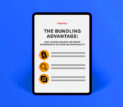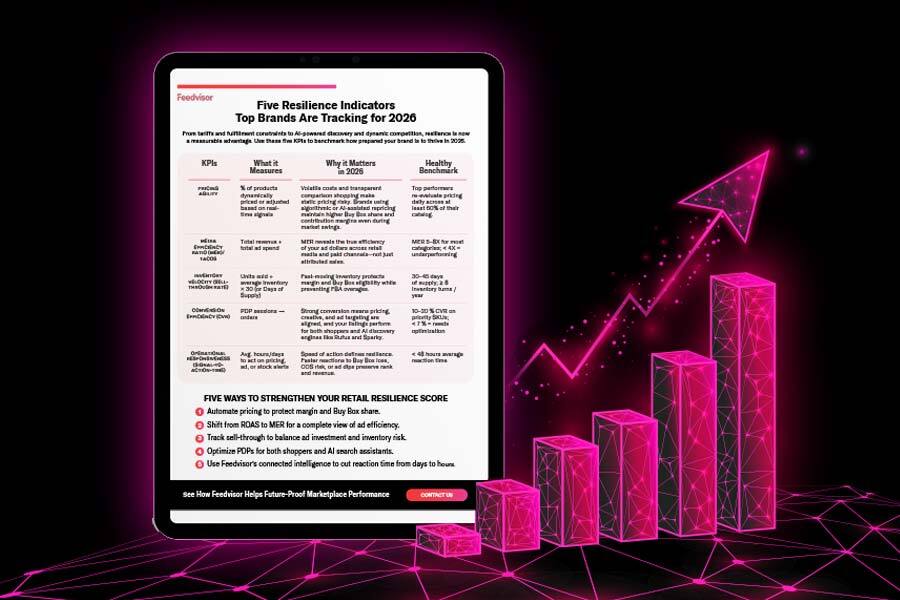
Categories
Latest Posts
Tags
Advertising Amazon Amazon Advertising Amazon Experts Amazon Listing Optimization Amazon Marketplace Amazon News Amazon Prime Amazon Professional Sellers Summit Amazon Seller amazon sellers Amazon Seller Tips Amazon Seller Tools ASIN Brand Management Brands Buy Box Campaign Manager Conference COVID-19 downloadable Dynamic Pricing Ecommerce FBA FBM Holiday Season industry news Multi-Channel Fulfillment Optimize pay-per-click Pricing Algorithm Pricing Software Private Label Profits Repricing Repricing Software Revenue Sales Seller Seller-Fulfilled Prime Seller Performance Metrics SEO SKU Sponsored Products Ads Strategy
Get the latest insights right in your inbox
Resource | Blog

Take Back Control: Why 3P Selling Might Be Your Best Bet Against Tariffs
SUMMARY
Learn why 3P selling might be your best bet against rising tariffs and how to get started with Feedvisor.

Marissa Incitti
If you’re a brand or manufacturer selling through retail partners like Amazon or Walmart’s 1P model, the past few weeks may have felt unsettling, to put it mildly. On top of existing tariff pressures, the end of the de minimis rule—which previously allowed imports valued under $800 to bypass certain tariffs—has officially closed. That means more duties, higher costs, and fewer loopholes to keep margins intact.
In this new environment, your success comes down to one thing: control.
Margins are tightening, and 1P sellers are at the mercy of retail partners when it comes to pricing, supply chain, and promotional timing. If you’ve felt boxed in by rigid terms, unpredictable purchase orders, or inflexible pricing rules, it might be time to rethink your go-to-market strategy.
This is where 3P selling shines. By selling directly on the marketplace, you unlock the levers you need to respond to market changes—on your terms. Here’s why switching from 1P to 3P could be your best defense against the rising tide of tariffs.
What’s the Difference Between 1P and 3P? (A Quick Recap)
Before we dive deeper, a quick refresher:
- 1P (First-Party): You act as a wholesale supplier. Amazon or Walmart buys your inventory and sells it directly to consumers.
- 3P (Third-Party): You sell products directly to consumers via Amazon Seller Central or Walmart Marketplace, managing your own listings, pricing, and inventory.
For years, many brands stuck with 1P because it felt easier. But with recent regulatory shifts and escalating import costs, ease no longer equals sustainability.
Here’s a more in-depth look at 1P vs. 3P.
“1P can feel like flying commercial—you’re on the ride, but you’re not in the cockpit. With 3P, you’re the pilot.”
Matt Visone, Director of Customer Success

Take Back Control of Your Margins
Tariffs may be out of your hands—but your pricing strategy isn’t. Talk to us today and turn uncertainty into opportunity.
Tariffs Are Here to Stay—And They’re Costing You
The end of the de minimis rule is just the latest in a series of tariff-related blows. U.S. trade policy is increasingly focused on reshoring and taxing imports, especially from China. These added costs eat directly into your bottom line—and 1P sellers often have the fewest options for response.
In a 1P relationship, you don’t control your price. The retailer sets it. You can’t easily change your suppliers or renegotiate sourcing terms without weeks (or months) of renegotiation. When new duties hit, you shoulder the burden alone —and the red ink.
3P = Control Where It Matters Most
Transitioning to 3P selling doesn’t just give you operational freedom—it gives you strategic flexibility that’s crucial when tariffs threaten profitability.
1. Pricing Power
1P vendors have limited ability to pass through price increases. Amazon dictates purchase order prices and can refuse cost increases. Brands then absorb the full impact of tariffs unless Amazon agrees to renegotiate, which it rarely does. However, 3P sellers can set retail prices that reflect true landed cost.
Essentially, as a 3P, you own the price. You can adjust in real time to reflect rising COGS, shift pricing across marketplaces, and create dynamic promotions that protect profitability while driving sales.
“When tariffs hit, you can’t afford to wait for a retail partner to adjust prices—you need real-time control.” — Matt Visone, Director of Customer Success
2. Supply Chain Flexibility
Tariff hikes can make certain suppliers or SKUs instantly unviable. 1P sellers often have limited flexibility to change vendors quickly due to POs and fixed replenishment terms.
As a 3P seller, you’re free to diversify suppliers, test new sourcing locations, or switch fulfillment methods (e.g., moving from China to Mexico or domestic partners) without the delays of retail gatekeepers.
3. Promotional & Inventory Strategy
With 1P, your promotional calendar is tied to Amazon or Walmart’s retail strategy. You may be required to participate in price cuts or deal events that don’t align with your cost structure.
3P sellers, on the other hand, choose when to run deals and how deep to discount, using real-time data and demand forecasting to align promos with tariff-adjusted margins. 3P sellers can also easily test bundles, introduce new variations, and run targeted promotions without waiting for Amazon to approve or adopt new listings, which can be critical in a time when differentiation and value storytelling are essential to justify higher price points.
3P Doesn’t Mean Going It Alone
One of the biggest myths about switching to 3P is that you have to manage everything manually. The truth is, 3P sellers today have more automation, data, and marketplace support than ever before.
You can still use FBA (Fulfilled by Amazon) or WFS (Walmart Fulfillment Services) for streamlined logistics. For everything else, use optimization software. Feedvisor’s AI-powered tools, for example, help 3P sellers:
- Dynamically price based on supply chain costs and demand
- Optimize ad spend to drive profitability, not just traffic
- Price based on demand to win the transaction on the search page
And for many brands, the smartest path isn’t an “either/or”—it’s a hybrid strategy. You can start by testing high-risk or tariff-sensitive SKUs on 3P while keeping evergreen items in 1P.
“3P selling is no longer a scrappy backup plan—it’s a modern, resilient go-to-market model.” — Brand Leader, Feedvisor 2025 Brand Survey
When Does Switching to 3P Make Sense?
Here are a few signs it’s time to reconsider your model:
- Your margins are getting squeezed by tariffs and shipping fees
- You need faster control over pricing and supplier changes
- You want to expand into new marketplaces or DTC
- You’re tired of unpredictable POs and retail compliance pressure
- You want more flexibility to run promotions on your schedule
“3P selling is no longer a scrappy backup plan—it’s a modern, resilient go-to-market model.”
Brand Leader, Feedvisor 2025 Brand Survey
Final Thoughts: Own Your Margins, Own Your Future
The de minimis loophole is gone. Tariffs are rising. And supply chains are more unpredictable than ever. In this climate, brands who take control of their selling strategy will come out ahead.
3P selling gives you that control. It gives you the power to adjust pricing, pivot suppliers, and run your business the way you want—without waiting for a retail partner to catch up.
Ready to make the switch—or strengthen your 3P game?
Explore how Feedvisor helps top brands optimize pricing, ads, and marketplace strategy in a post-tariff world.
To truly thrive on Amazon, you need precision, intelligence, and a holistic strategy. That’s where Feedvisor comes in. Our AI-powered advertising optimization takes the guesswork out of DSP campaigns and AMC analysis. With our data-driven technology and expert team, we’ll help you strategically plan, implement, and refine your campaigns—maximizing conversions and exceeding your goals every step of the way.
Ready for a new, holistic approach to your ad strategy, powered by AI? Start your 14-day free trial today.




